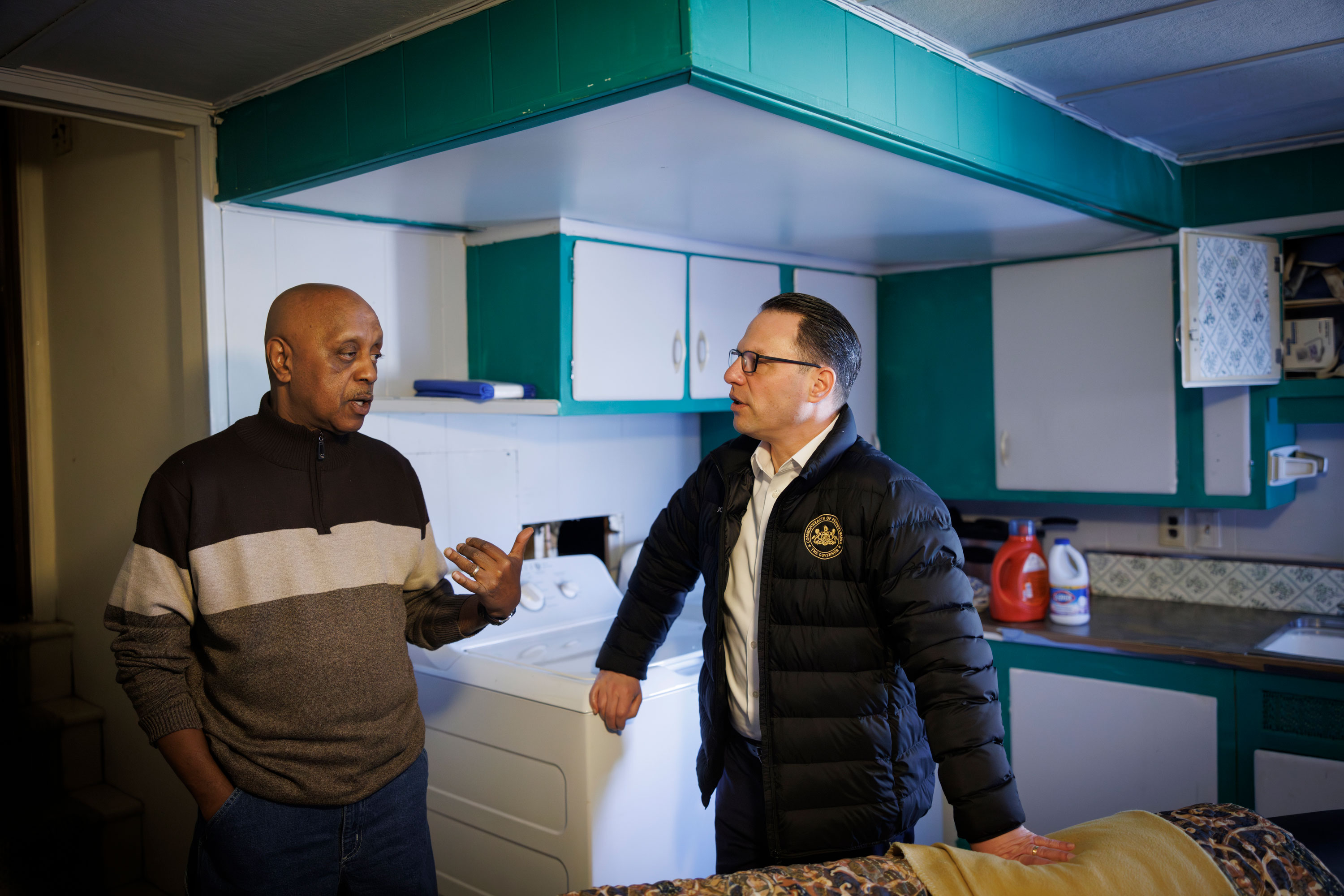Ask the Experts
Ask the Experts: Exploring the impacts of a cap-and-trade program
Advocates weigh in on Shapiro’s energy plans and how they could impact Pennsylvania

Pennsylvania Consumer Advocate Patrick Cicero speaks at a press conference on Gov. Josh Shapiro’s plan. Commonwealth Media Services
The yearslong debate over Pennsylvania’s energy policies – and how they could incentivize renewable energy production – has entered its next phase. Gov. Josh Shapiro unveiled two energy plans in March designed to reduce emissions from the electric generation sector and build on a law that requires electricity generators to generate a portion of their power from alternative energy sources.
The proposals – the Pennsylvania Climate Emissions Reduction, or PACER, and the Pennsylvania Reliable Energy Sustainability Standard, or PRESS – are two new acronyms in an energy discussion that has become so complicated that it has even wonks wondering what the best path forward is.
Shapiro’s PACER proposal – an alternative to the state’s entrance into the controversial multistate cap-and-trade compact known as RGGI – would require the Department of Environmental Protection to set emissions caps for the state’s power plants and have plants pay for carbon allowances, with revenues from the allowances going toward programs to offset energy costs and support communities impacted by job loss and pollution.
The PRESS proposal would expand on the state’s Alternative Energy Portfolio Standards Act, requiring the state to obtain 50% of its electricity from a diverse range of energy resources by 2035, including 35% from clean energy sources.
City & State spoke to three experts deeply involved in energy and environmental discussions: Patrick McDonnell, president and CEO of PennFuture; Rachel Gleason, executive director of the Pennsylvania Coal Alliance; and Patrick Cicero, the Pennsylvania Consumer Advocate, on the proposals and how everyone from producers to consumers could be impacted going forward.
These conversations have been edited for length and clarity.
What are your thoughts on Shapiro’s PACER proposal and how it differs from RGGI?
PM: As we went through RGGI, there was a lot of modeling that was done to end up at the cap that was ultimately developed for the program. So the stringency test is: Are we getting the same kind of carbon reductions under any other proposal we would have been getting under RGGI? That question has yet to be answered because it will depend on the cap and exactly how all the revenue is spent … It’s both how you spend the money from the auction and where you set the cap that ultimately determines where you are going to be at the end of the day in terms of actual carbon reductions.
RG: It’s worse than RGGI from a policy perspective. It still does not address that we’re not an island … We are the largest exporter of electricity in the United States. I find it interesting that Shapiro is clearly putting carbon dioxide reductions before reliability and affordability. Reliability continues to not be addressed … Conventional thermal generation is retiring at an unprecedented rate largely because of misguided policy decisions, and new resources that are reliable and resilient are not coming on the grid at a sufficient pace.
Critics of a state-specific cap-and-trade program argue that it doesn’t take into account the states Pennsylvania shares an electrical grid with. What are your thoughts on how we compare to states like Ohio and West Virginia, and should a plan ensure our regional transmission organization, PJM, is involved?
PM: One of the things that we’ve seen in surrounding states is real investment in renewable energy. Even in places they would point to, like Ohio and West Virginia, they’re now doing better than us in energy efficiency and on renewable energy. I think they are seeing where the future is in terms of what demand is going to be, not just in terms of kilowatt hours but where those kilowatt hours come from. You look at a state like West Virginia, which gets very associated with coal and trying to be protective of that. They’re also building one of the largest battery manufacturing facilities in the U.S. right now with federal dollars. You look at a state like Ohio, they are building electric vehicle component manufacturing and have dedicated programs for that. Those are the kinds of things I think a carbon trading program gives us the ability to do.
RG: The RGGI working group that Shapiro put together did not recommend attempting a carbon tax scenario. They only recommended a cap-and-trade type of scenario that was PJM-wide … because that’s the only way you address leakage of energy. That’s another thing that his plan does not address: leakage.
PC: The biggest unintended consequence is the lack of coordination between state-level policy and the policy for our regional transmission organization, PJM. PJM’s inability to predict or accommodate thermal generation retirements with the onboarding of non-thermal resources like wind and solar and the development of things like battery storage shows there is not a predictable path or integrated resource planning. One of the biggest challenges is that no one’s paying attention to the transmission build-out.
Can you elaborate on some of those concerns related to leakage and transmission build-out, as it relates to either PACER or PRESS?
RG: With PRESS, you’re upping certain AEPS requirements to 50%, which are all unreliable sources, and then requiring other fuel sources that either are not available or are not proven technologies. You’re going to have a serious issue with reliability on the grid. And sadly, I think it might come to blackouts or brownouts until folks really realize what these misguided policies create.
PC: The solution that everybody has talked about is to build more transmission to deal with the loss of the thermal load – but that’s a really expensive proposition. It’s about figuring out how Pennsylvania, as an energy exporter, gets to say, “We don’t need to build more transmission.” It’s Maryland, New Jersey, Washington, D.C., and Northern Virginia that need more transmission because of their policy choices, not ours. It comes back to the federalism debate between the federal government, the delegating authority at PJM, and Pennsylvania. It’s a real problem that’s going to come to a head either in the courts or otherwise. The lack of any kind of integrated resource planning about how you align onboarding new and broader base resources – it’s a challenge.
And how do you see these proposals potentially impacting jobs in the energy sector?
RG: Immediately harmed by punting sources to a third tier of energy standards would be the coal refuse plants that rely on the current state Tier II credit, as well as manufacturers who benefit from the current Tier II credit for power generated from like byproducts still making processes.
PM: What we’re talking about are things that are both important environmentally, important for climate but also important for job creation. Again, I don’t want to be losing jobs to surrounding states. We see that this is a big portion of their plans for economic development, so we should make sure we’re not just as ambitious but more ambitious, and I think having PRESS and PACER kind of working in tandem is a good way to really start to get there.

Two other major areas of concern are reliability of the grid and energy costs for ratepayers. Can you elaborate on some of those concerns and how PACER could impact the grid and consumer costs?
RG: Everything has a cost. When you discourage reliable thermal generation and encourage and subsidize unreliable generation, that’s going to impact utility bills … It’s unclear to me if it’s all residents of the commonwealth or low-income residents of the commonwealth who would receive rent relief, but it also doesn’t address businesses. The governor says that he’s actually losing to “friggin’ Ohio.” But if you’re going to increase utility rates for large manufacturing-type businesses in Pennsylvania, they are going to bear the brunt of the higher cost of electricity that results from these plants – then you’re going to lose to Ohio.
PC: The question of reliability and cost are inextricably entwined. I think it’s a bit of a false dichotomy that has been presented that we don’t have to have an “either-or” – either we have reliability and it’s expensive, or we have no reliability, but we don’t do anything. I reject that notion. We can do both. I think what we need to do is figure out how Pennsylvania, with its vast energy reserves, can ensure that Pennsylvania households, businesses and industries can make sure that they’re getting access to that before we export the energy … To some degree, it requires a level of political will and a comprehensive plan – those are the two missing ingredients.
How would you like to see any potential increased consumer costs remedied, either through legislative or regulatory moves?
PC: For all consumers, there are tools that the General Assembly has discretion over to use immediately, which would involve the gross receipts tax. On electricity bills, there is a gross receipts tax that is charged. That gross receipts tax is near 6%. This generates close to $8 billion – with a “B” – here. Any environmental policy, any mitigation policy, any policy that is about incentivizing the building of thermal generation – whether it’s environmental thermal generation or anything else – that has cost impacts, meaning it’s going to cost consumers more. The cost impacts of that can be offset by a reduction in the gross receipts tax.
That creates a revenue hole for the General Assembly to figure out how they’re going to fill it, but that’s why, with a program like PACER or PRESS, it can accommodate this if you’re directing a significant portion of the proceeds from this back to Pennsylvania ratepayers … Independent of cap-and-trade, if we never did RGGI or PACER, those cost pressures can be mitigated for ratepayers, whether they’re large businesses, small businesses or Joe the residential consumer as offset to the gross receipts tax. But again, that would create dynamics with the General Fund that would have to be contended with. The General Assembly and the governor’s office are fully capable of managing a large budget. But those are direct energy costs right now, and they could be easily mitigated impacts. Reserve the liability and preserve affordability for low-income households. The General Assembly also can – and should – consider funding LIHEAP year-round … If you have a cap-and-invest program that generates revenue, you can pass those savings on gross receipts tax, but then you’re not losing revenue. It’s just a matter of what they want to do.
Renewable energy voices argue that coal facilities and other fossil fuels are already shutting down due to market forces. Do you think, given the shutdowns, there should be a statewide program in place to support impacted workers and communities?
PM: We see just with Homer City, that plant was projected to close in the future and it is now closed. We need jobs in that community. Those jobs don’t have to be in solar or wind. I think having manufacturing, in particular, helps … I don’t want to install solar panels; I want to build them. I don’t want to sell electric cars, I want to build them. RGGI or a carbon trading program of any sort gives us resources in order to be helpful in those communities. Every coal plant in the state has an end date, and in some places, a lot of it is driven by water quality requirements. So we know the coal is going away. At this point, I don’t want to tell any worker that this is the job they should have. I think it’s the role of the commonwealth to make sure we have a robust economy that allows them to pursue opportunities.
RG: I would be open to working with folks to address those issues when such large resources get shuttered because of policy decisions … I will be up for that conversation. I mean, the market is our policy decisions that force and subsidize unreliable sources.

What do you think is a topic or issue not being addressed in these policy discussions?
RG: It’s a policy proposal, but it doesn’t really address the real-life scenarios. If you look back, especially on a national and state level, where folks are encouraging increased electrification and batteries, all of these other things are just going to put more pressure on the grid. I think we really need to look at where we would be if there were another Winter Storm Elliot, where 70% of resources didn’t show up when they were called upon and coal saved the day.
PC: Ensuring that Pennsylvania remains an attractive place to do and site business has everything to do with energy costs … We’re unique. We are the Keystone State for a reason. For heaven’s sake, we need to own it … We’re missing an opportunity to throw our weight around in the context of this policy debate and create economic incentives for businesses to be here that don’t harm the ratepayers who are paying for energy bills.
